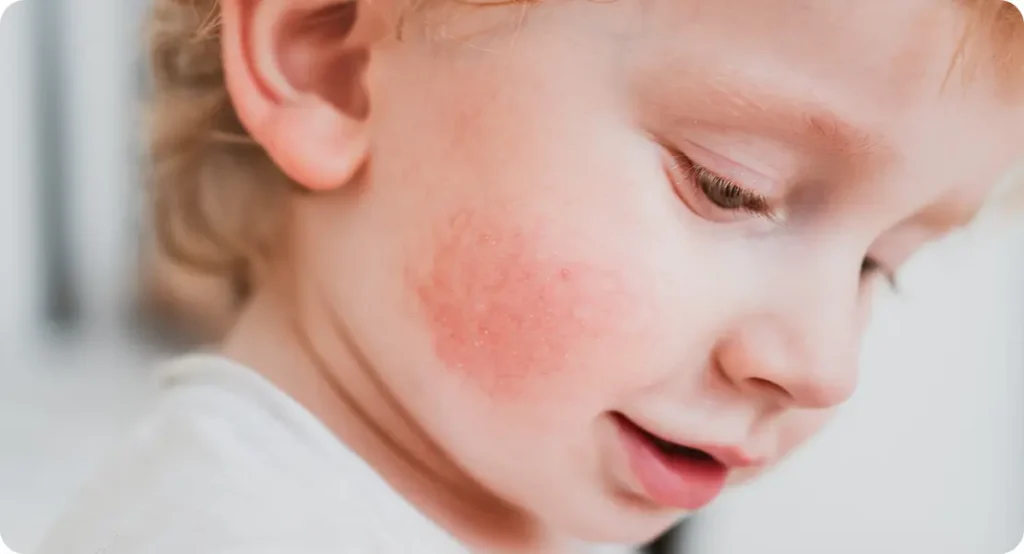Childhood eczema is no longer seen as a simple rash it’s now recognised as a complex, chronic condition affecting millions of children worldwide. Parents today face an emotional and physical struggle as they watch their children deal with the constant itching, sleepless nights, and painful flare-ups. But alongside the growing prevalence of eczema, science is making big strides in understanding what causes it and how to treat it better.
Recent research has uncovered key links between eczema and weakened skin barrier function, specific immune system behaviours, and even the bacteria that live on our skin. This knowledge is changing how doctors view eczema, revealing that it isn’t just one disease but a group of subtypes that need tailored care. From groundbreaking genetic discoveries to the rise of microbiome therapies and biologic injections, the future of eczema treatment looks promising.
This article breaks down 20 key insights from the latest eczema research in a simple, direct way. Whether you’re a parent, caregiver, or someone looking to understand this condition better, you’ll find practical information and hope in these pages. Science is finally catching up to what families have known all along eczema is more than skin deep, and the way we treat it is changing fast.
1. Eczema in Children: A Rising Concern
Childhood eczema, or atopic dermatitis, has become increasingly common in recent years. In the UK, it now affects around one in five children, making it a leading chronic skin condition in paediatrics. It’s more than a simple rash it causes discomfort, sleep disruption, and social stress for both children and parents.
Experts believe changes in lifestyle and environment are contributing to this rise. Children today spend more time indoors, encounter fewer microbes, and are exposed to more pollutants and chemicals. This limits the immune system’s ability to develop properly, possibly leading to higher allergy risks.
Eczema can deeply affect a child’s quality of life, from missed school days to anxiety about appearance. Parents often struggle to find consistent treatment that works. Fortunately, awareness and research are growing, offering better tools to manage and understand the condition.
2. Genetics and the Role of Skin Barrier Dysfunction
One of the most important discoveries in eczema research is the role of the skin barrier. Many children with eczema have a mutation in the FLG gene, which reduces the production of filaggrin a protein that helps seal and protect the skin. Without it, the skin dries out and allows irritants and allergens to enter more easily.
This weak barrier can cause chronic inflammation and increase sensitivity to everyday substances like dust or soap. It also raises the risk of developing asthma or hay fever, a pattern known as the “atopic march.” However, not every child with eczema has this gene mutation.
Knowing this has helped doctors shift focus towards barrier repair. Treatments now include moisturisers with ceramides and lipids to mimic the skin’s natural defences. Strengthening the barrier is a vital step in long-term eczema control, especially for children with genetic risk.
3. Subtypes of Childhood Eczema: Not One Size Fits All

Eczema doesn’t present the same way in every child. There are different subtypes, with the two main ones being extrinsic (allergic) and intrinsic (non-allergic) eczema. Extrinsic eczema is more common and is linked to high IgE levels and other allergic conditions like asthma and hay fever.
Intrinsic eczema, however, shows no signs of allergic reaction but causes similar itching and skin changes. It can be harder to diagnose because it doesn’t respond to allergy testing. Despite the different causes, both types can cause equal discomfort and distress.
Recognising the subtype helps doctors choose the right treatment and avoid unnecessary allergy management. Personalised care plans are becoming more common, tailored to a child’s specific eczema type. This approach is improving outcomes and giving families more clarity and control.
4. The Immune System’s Role in Eczema
The immune system plays a major role in the development and persistence of eczema. In children with eczema, the immune system tends to overreact to harmless substances like dust or certain foods. This overreaction causes inflammation and the release of chemicals that worsen itching and redness.
Cytokines like IL-4 and IL-13 are involved in this process, leading to chronic irritation even without visible triggers. This also explains why eczema often flares unpredictably. Scratching further damages the skin, creating a vicious cycle.
Understanding the immune link has led to new treatment options. Doctors are now using immune-targeting therapies to calm this overactivity. These treatments aim to stop the inflammation at its source, not just soothe the symptoms.
5. The Microbiome: A New Player in Skin Health
The skin is home to millions of bacteria, fungi, and other microbes that help maintain skin health. This collection of organisms is known as the skin microbiome. In children with eczema, the microbiome is often unbalanced, with harmful bacteria like Staphylococcus aureus taking over.
This imbalance can make the skin more prone to flare-ups and infections. Everyday triggers like sweating, soap, or pollution can worsen the issue. Antibiotics and antibacterial washes sometimes help but can also reduce good bacteria.
Newer treatments focus on restoring a healthy microbiome rather than killing all bacteria. Probiotic creams, microbiome-friendly skincare, and gentle cleansing routines are being studied and used more often. These solutions aim to support the skin’s natural defences in the long term.
6. Eczema and Allergies: A Close Connection
Eczema is closely linked with other allergic conditions, especially in children. Many young patients also suffer from asthma, hay fever, or food allergies forming what doctors call the “atopic triad.” This connection helps explain why eczema often appears as the first sign of a child’s allergic tendency.
Food allergies in particular can trigger eczema flare-ups. Common culprits include dairy, eggs, nuts, and wheat. While not every child with eczema has food allergies, managing diet can make a significant difference for some.
Doctors usually recommend allergy testing if eczema is severe or linked to digestion problems. But it’s important not to remove foods without proper guidance. Balancing nutrition and eczema care is key to long-term health.
7. Environmental Triggers and Flare-Ups
The environment around a child can have a big impact on eczema. Everyday things like pollen, dust mites, pet dander, and even cold weather can cause flare-ups. These triggers vary from child to child, making eczema highly personal and unpredictable.
Harsh soaps, wool clothing, and central heating can dry out the skin and increase irritation. Even stress and sweating can lead to more itching and discomfort. That’s why keeping a trigger diary can be helpful.
Reducing exposure to known irritants is part of good eczema management. Simple changes like switching laundry detergents or using a humidifier can reduce flare-ups. It’s all about finding what works best for the individual child.
8. The Emotional Impact on Children and Families

Eczema doesn’t just affect the skin it affects emotions too. Children may feel embarrassed, frustrated, or isolated, especially when eczema is visible on the face or hands. This can lead to anxiety or even bullying at school.
The constant itching often disrupts sleep, leaving kids tired and parents exhausted. It puts pressure on the whole family, as routines are built around managing creams, baths, and flare-ups. The emotional toll is real and often overlooked.
Support groups, counselling, and speaking openly about eczema can make a big difference. Families need understanding from schools, relatives, and doctors. Addressing mental health is just as important as treating the skin.
9. The Challenge of Night-time Itching
Night-time is often the worst for children with eczema. Itching tends to intensify after bedtime, disrupting sleep and leading to fatigue the next day. Both the child and parents may suffer from poor rest, creating tension and exhaustion.
Warm temperatures under blankets, dry indoor air, and sweat can trigger more itchiness. Scratching in sleep can cause skin damage and bleeding. Some children even wake with blood-stained sheets or cracked skin.
To help, parents can use breathable cotton bedding and keep the room cool. Applying moisturiser just before bed can also reduce dryness. In some cases, wearing soft gloves at night may stop unconscious scratching.
10. Moisturising: A Daily Eczema Essential
Moisturising is one of the most important steps in managing childhood eczema. It helps lock in hydration and protects the skin from drying out. Doctors often recommend applying emollients at least twice a day, especially after bathing.
Not all creams are the same thicker, fragrance-free options tend to work best. Ointments and balms are especially useful during colder months or severe flare-ups. Light lotions may not offer enough protection for eczema-prone skin.
Consistency is key, even when the skin looks clear. Regular moisturising can reduce flare-ups and the need for stronger medication. It’s a habit that makes a real difference over time.
11. The Role of Topical Steroids in Treatment
Topical steroids have long been the go-to treatment for eczema flare-ups. They reduce inflammation and calm down red, itchy patches quickly. When used properly, they’re safe and effective for children.
Parents often worry about side effects, especially skin thinning. However, under medical guidance, these risks are very low with short-term use. Problems usually occur when steroids are overused or used incorrectly.
Doctors usually advise using them during flares, then tapering off as the skin improves. The key is to follow instructions carefully and avoid sudden stops. Steroids can be an important part of treatment not the enemy.
12. Non-Steroid Treatments and Barrier Repair
While steroids help during flare-ups, long-term care relies heavily on non-steroid treatments. These include moisturisers enriched with ceramides and barrier-repair creams that restore the skin’s defences. They work by sealing in moisture and reducing vulnerability to irritants.
Some products also contain natural oils, oats, or niacinamide to soothe and heal the skin. They can be used daily, even when the skin appears normal. This helps prevent new flares before they start.
Non-steroid options are especially useful for children with sensitive skin or long-term eczema. They offer gentle, consistent care without the risks linked to stronger medications. Used well, they can dramatically reduce the need for steroids.
13. The Rise of Biologic Treatments
In recent years, biologic medicines have changed how doctors treat severe eczema. These targeted drugs work by blocking specific parts of the immune system that cause inflammation. One of the most common is dupilumab, approved for use in children over six months old.
Biologics are usually given by injection and are used when other treatments fail. They’re showing promising results with reduced itching, fewer flares, and better quality of life. Unlike steroids, they don’t thin the skin or cause dependency.
However, biologics are expensive and require close medical supervision. They’re not for every child but can be life-changing in severe cases. As research grows, more biologics are being developed to offer even more options.
14. The Promise of Microbiome Therapies
Scientists are exploring new ways to treat eczema by focusing on the skin’s microbiome. These treatments aim to boost good bacteria and reduce harmful microbes like Staphylococcus aureus. A healthier skin microbiome could mean fewer infections and less inflammation.
Some therapies involve applying live bacteria directly to the skin. Others use ingredients that feed helpful microbes and crowd out the bad ones. These methods are still new but show encouraging results in clinical trials.
Microbiome therapies are gentle and don’t suppress the immune system. They offer a natural, long-term solution, especially for young children. In future, they could become a regular part of eczema care routines.
15. Managing Eczema in School and Daily Life
Eczema can affect a child’s confidence and focus in school. Itching, pain, or visible patches may distract them from learning or lead to embarrassment. Teachers and classmates might not always understand how serious the condition is.
Schools can help by allowing regular moisturising breaks and excusing children from certain activities. Wearing cotton uniforms and avoiding strong cleaning products also helps. Parents should inform school staff about their child’s needs and triggers.
A daily routine that includes skin care, rest, and nutrition can support better management. With the right adjustments, children with eczema can enjoy a full, active school life. Support at home and at school is key to their comfort and confidence.
16. Weather and Seasonal Changes
Weather plays a big role in eczema flare-ups. Cold, dry air in winter often worsens dryness and itching, while heat and sweating in summer can trigger inflammation. Sudden changes in temperature can also stress the skin.
During colder months, using thicker creams and a humidifier at home can help retain moisture. In summer, lightweight moisturisers and breathable clothing reduce irritation. It’s all about adapting care based on the season.
Planning ahead can make transitions easier for children with eczema. Keeping up with treatment routines, regardless of season, is essential. With a few smart adjustments, most flare-ups can be minimised.
17. Diet and Nutrition in Eczema Management

Food isn’t always the cause of eczema, but it can be a trigger in some children. Common culprits include dairy, eggs, nuts, soy, and wheat. However, cutting out foods without guidance can cause nutritional gaps.
An allergy test can help identify real food sensitivities. Dieticians can support safe elimination diets when needed. It’s important to focus on a balanced, anti-inflammatory diet rich in whole foods.
Omega-3 fatty acids, found in flaxseeds and oily fish, may reduce inflammation. Staying hydrated also supports healthy skin. While diet alone may not cure eczema, it can be a helpful part of the wider care plan.
18. Eczema and Sleep: Breaking the Cycle
Sleep is often disrupted in children with eczema, especially during flares. The constant itching leads to scratching at night, which makes the skin worse and the child tired. It’s a frustrating cycle for both children and parents.
Lack of sleep can affect mood, behaviour, and even school performance. Kids may become irritable or withdrawn during the day. This daily tiredness puts a strain on the whole family.
To support better sleep, experts suggest a consistent bedtime routine and moisturising right before bed. Keeping the room cool and using cotton sheets can also help. In severe cases, doctors may recommend antihistamines for temporary relief.
19. Supporting Parents and Caregivers
Managing a child’s eczema can be emotionally draining. Parents often feel guilt, frustration, or helplessness when treatments don’t work. The condition can also lead to financial stress due to doctor visits and skincare costs.
Support groups and online communities can offer practical advice and emotional reassurance. Speaking with dermatologists or paediatricians regularly helps build confidence. You’re not alone many families are facing similar struggles.
Caregivers need to prioritise their own wellbeing too. When parents are supported, they can manage routines more effectively and avoid burnout. Healthy families make for healthier outcomes.
20. The Future of Eczema Care: Personalised and Preventive
The future of eczema care is moving towards personalised treatment. Advances in genetic testing, immune profiling, and microbiome analysis are helping doctors tailor solutions to each child’s needs. This means faster relief and fewer side effects.
Wearable tech may soon help track scratching, hydration, or triggers in real time. Preventive strategies like treating skin early in high-risk babies are also gaining attention. Early care could stop eczema before it becomes severe.
Ongoing research is focused on long-term, non-steroid solutions. With new therapies emerging and better understanding of the condition, hope for children and families is stronger than ever. The goal is not just treatment, but lasting control and improved quality of life.
Final Thoughts: A Brighter Outlook for Children with Eczema
Childhood eczema is no longer just a surface-level condition it’s a complex interaction of genetics, immunity, skin function, and environment. As research deepens, we’re seeing real progress in managing the condition with more targeted, effective care. From barrier-repair strategies to biologic treatments and microbiome therapies, families now have more options than ever before.
Consistency, early intervention, and emotional support remain key to helping children thrive. It’s not just about soothing symptoms it’s about improving quality of life at home, in school, and beyond. Support for parents and tailored plans for each child make all the difference.
You can get in touch with us at The London Dermatology Centre to book a consultation with one of our expert paediatric dermatologists. We’ll help guide you through the latest treatment options, tailored to your child’s needs. With new solutions emerging and better understanding every day, the future of eczema care is full of hope.
Five Academic References (Harvard Style):
- Bieber, T. (2020) ‘Atopic dermatitis’, The New England Journal of Medicine, 383(23), pp. 2281–2294.
- Irvine, A.D., McLean, W.H.I., & Leung, D.Y.M. (2011). Filaggrin mutations associated with skin and allergic diseases. New England Journal of Medicine, 365(14), 1315–1327.
Available at: https://www.nejm.org/doi/full/10.1056/nejmra1011040 - Nakatsuji, T. & Gallo, R.L. (2019). The role of the skin microbiome in atopic dermatitis. Annals of Allergy, Asthma & Immunology, 122(3), 263–269.
- Paller, A.S., Kabashima, K., & Bieber, T. (2019). Clinical and molecular phenotype of early-onset pediatric atopic dermatitis. Journal of Allergy and Clinical Immunology, 144(6), 1556–1564.e1.
- Simpson, E.L., Bieber, T., Guttman-Yassky, E., et al. (2016). Two phase 3 trials of dupilumab versus placebo in atopic dermatitis. New England Journal of Medicine, 375(24), 2335–2348.
Available at: https://www.nejm.org/doi/full/10.1056/NEJMoa1606490
